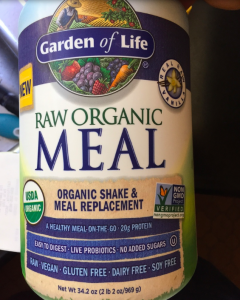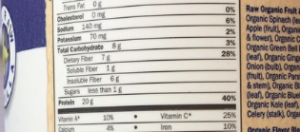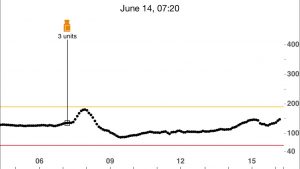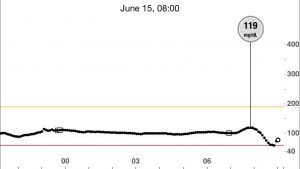I spent years after my initial diagnosis of Type 1.5 diabetes striving to limit my blood sugar for the purpose of not using insulin. That is a nuanced objective that tripped me up for a while after my exogenous insulin production finally dropped (after 8-9 years) to the point that using insulin became a requirement. I had to make the psychological shift from striving to “not use insulin” even if my short term numbers might rise higher than I would like, to keep my overall blood sugar low.
I wouldn’t have expected that this slight shift in objectives would have a massive impact on my behavior, but it did. I’ll dive into the specifics of that impact in other posts. For the moment, I wanted to point out simply what the impact is of NOT practicing portion control.
For those of us who come to using insulin later in life, it can mean many things. As I allude to above, one thing it meant for me was self criticism. (“I’ve failed! Now I must use insulin! Drat!”) Once I got over that, it became a liberation. “Yippee! Now I can eat what I want! All I need to do is bolus enough insulin to compensate!” Well…it’s not so simple.
I’m a father, and last Sunday was Father’s Day. The extended family gathered for a meal, and the dads were allowed to be lazy. We could eat and drink without reprimand. Good thing? Bad thing? It’s a mixed bag.
Yes, I loved the indulgence, but let’s look at what behavior that invited.
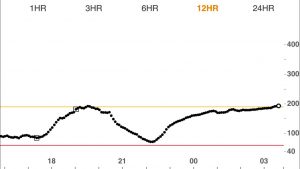
This is a readout of the prior 12 hours, with insulin boluses indicated by squares on the line plot. We arrived at my in-laws around 4:30 pm (16:30 military time). [As an aside, I keep my watches/phones running on military time, hence the double digits.] the eating began around 5:30 pm (17:30). I knew there was a bunch of delicious goodies to sample, so I bolused 4 units of Humalog – fast acting insulin.
The packaging for Humalog says that it acts over a four hour time period. I find that it takes about a half hour to kick in, and then it runs for only 3 hours for me. Everyone should gauge this for themselves because your milage may/will vary. You should also watch it in real time, because other factors like sleep, stress, illness will all impact that performance.
Within about an hour and a half, it was clear I had overdone it. Even with 4 units, I was already hitting my upper limit of 190. So I did what I rarely do, and bolused an additional 3 units!! (Don’t try this at home! That’s too much! 7 units all at once when I never have more than 4 is risky business. I must have thought I had really overdone it with the gluttony.) Despite that user warning, my numbers started to drop. You can see clearly in the graph that from my second bolus at 7 pm (19:00), the levels drop, and continue to drop almost exactly 3 hours.
The drop so successfully that I start to approach the lower limit. Happily I didn’t go any lower than I did. But then, at the three hour mark, they start to climb again. From 10:30 pm (22:30) on, I am still digesting the food and drink from the evening’s splurge. The levels rise again, climbing steadily to 4 am (04:00) when they cross back over the high alarm limit. My CGM sounds the alarm. I wake up. (So does my wife! She was on pins and needles as I flopped into bed at 10:30 pm (22:30) because I had drunk too much as well. She wasn’t sure what was going on, but hoped that my CGM would alert her if I went seriously sideways.) I go into the kitchen. I bolus another 3 or 4 units (I can’t recall), and go back to bed.
Father’s day had been super hot. I worked out in the yard before meeting with the extended family for our evening feed-fest, and I suspect I had not drunk enough water during the day either. The night was hot. I had fitful sleep. My FitBit told me my heart rate was much higher than normal overnight. I was a bit of a mess. But all’s well that ends well. By morning, I was a bit hung over, but blood glucose levels were normal again and I was on the mend.
The moral of this silly story is PORTION CONTROL. If I eat too much, and it can be too much of very low glycemic index foods like vegetables or cheese, it overloads my system somehow and taxes my blood sugar levels hours after eating.
This is an area where I need to develop greater personal discipline. I’m usually pretty good, but I still have my weak moments. What have you found helps you control your impulse to mow down the entire buffet? What do you think contributes to your having more self-control on some days, and less self-control on others?
